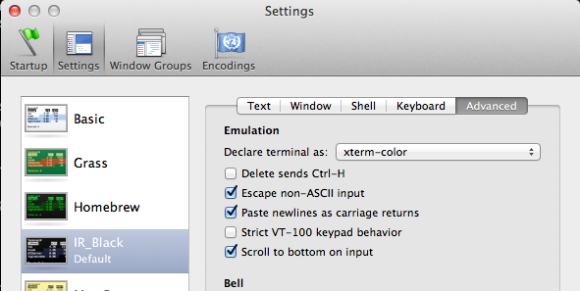When working in shells, it’s very useful to have syntax highlighting. In vim it’s just ‘:sy on’ and you’re done. For those of you using GNU Nano, I’ll show you how to enable syntax highlighting as well.
To start, we’ll need some files which tell nano what to display in what color. Here is an example of such a file for PHP:
nano /usr/share/nano/php.nanorc
syntax "php" "\.php|\.inc$"
color white start="<\?(php)?" end="\?>"
color magenta start="<[^\?]" end="[^\?]>"
color magenta "\$[a-zA-Z_0-9]*"
color brightblue "\->[a-zA-Z_0-9]*"
color cyan "(\[)|(\])"
color brightyellow "(var|class|function|echo|case|break|default|exit|switch|if|else|elseif|@|while|return|public|private|proteted|static)\s"
color brightyellow "\<(try|throw|catch|operator|new)\>"
color white "="
color green "[,{}()]"
color green "=="
color brightgreen "('[^']*')|(\"[^"]*\")"
color yellow start=""
color yellow start="/\*" end="\*/"
color yellow start="#" end="$"
color yellow "//.*"
Then we tell nano where this file is to be found:
nano /etc/nanorc
And add this line:
## PHP include "/usr/share/nano/php.nanorc"
You then should see this when editing a PHP file with nano:
You can do the same for Bash files. Here’s the config file:
nano /usr/share/nano/sh.nanorc
syntax "sh" "\.sh$"
icolor brightgreen "^[0-9A-Z_]+\(\)"
color green "\<(case|do|done|elif|else|esac|exit|fi|for|function|if|in|local|read|return|select|shift|then|time|until|while)\>"
color green "(\{|\}|\(|\)|\;|\]|\[|`|\\|\$|<|>|!|=|&|\|)"
color green "-[Ldefgruwx]\>"
color green "-(eq|ne|gt|lt|ge|le|s|n|z)\>"
color brightblue "\<(cat|cd|chmod|chown|cp|echo|env|export|grep|install|let|ln|make|mkdir|mv|rm|sed|set|tar|touch|umask|unset)\>"
icolor brightred "\$\{?[0-9A-Z_!@#$*?-]+\}?"
color cyan "(^|[[:space:]])#.*$"
color brightyellow ""(\\.|[^"])*"" "'(\\.|[^'])*'"
color ,green "[[:space:]]+$"
It’s pretty easy to customize if you want. So now you never have to edit scripts without syntax highlighting again!







